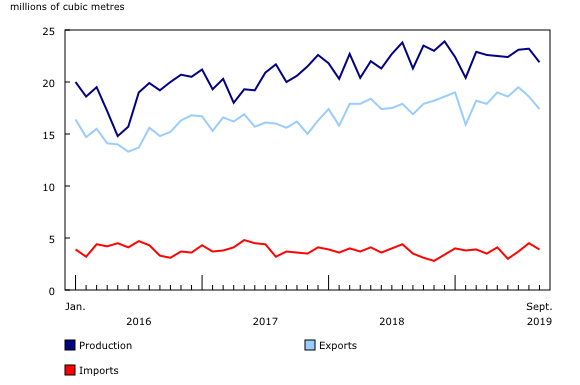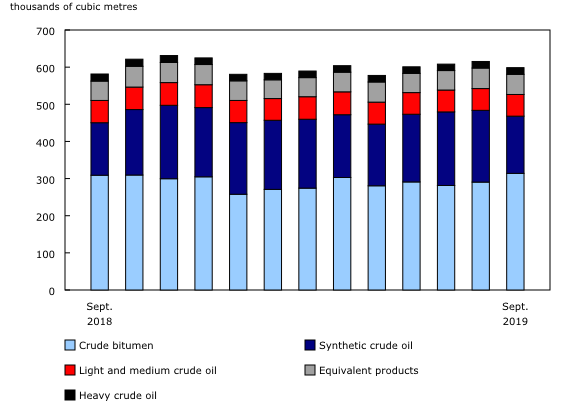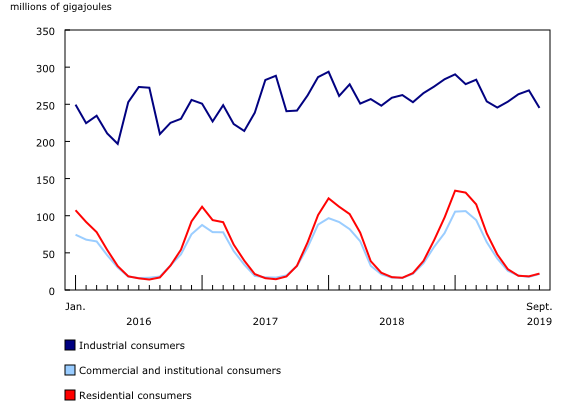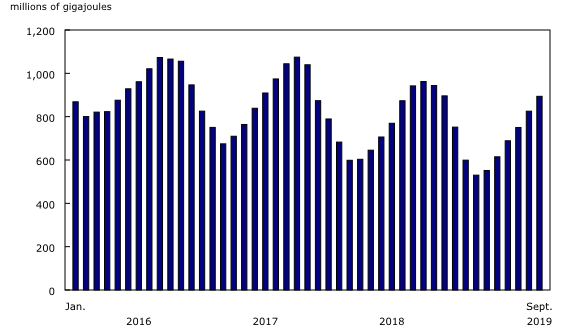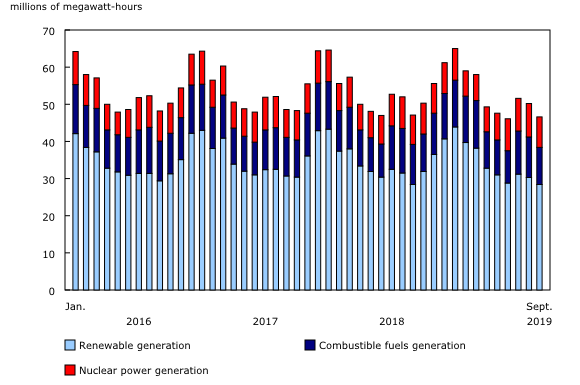Energy statistics, September 2019
Archived Content
Information identified as archived is provided for reference, research or recordkeeping purposes. It is not subject to the Government of Canada Web Standards and has not been altered or updated since it was archived. Please "contact us" to request a format other than those available.
Released: 2019-12-04
Production of crude oil and equivalent products (+2.8%) increased in September, while production of natural gas (-4.5%), electricity (-1.1%) and coal (-11.3%) declined compared with the same month in 2018. Over the same period, exports of crude oil and equivalent products (+3.3%) and electricity (+28.5%) rose, while exports of natural gas (-5.0%) were down.
For more information on energy in Canada, please visit the Canadian Energy Information Portal.
Crude oil and equivalent products
In September, production of crude oil and equivalent products rose 2.8% year over year to 21.9 million cubic metres (137.6 million barrels). The increase was attributable primarily to synthetic crude oil production, up 8.8% to 4.6 million cubic metres, compared with September 2018, when maintenance and repairs limited production at an Alberta oil sands facility. Crude bitumen production (+1.7%), equivalent products (+6.1%), and light and medium crude oil (+0.1%) also contributed to the overall increase in September. Meanwhile, heavy crude oil production decreased 2.5% to 1.9 million cubic metres.
Despite the year-over-year increase, planned maintenance shutdowns at some oil sands facilities in Alberta and ongoing operational and maintenance issues affecting Newfoundland and Labrador's offshore crude oil facilities in September resulted in the lowest monthly production level since February 2019.
Alberta produced 18.0 million cubic metres of crude oil and equivalent products in September, up 2.9% compared with September 2018, and accounted for 82.1% of total Canadian production.
Average daily production of crude oil and equivalent products in September was down 2.7% from the previous month to 598.6 thousand cubic metres. This was the lowest average daily production level in four months and was primarily because of planned maintenance at several upgraders in northern Alberta.
Saskatchewan (10.4% of total production) and Newfoundland and Labrador (3.8%) were also key producing provinces in September.
Pipelines in Canada received 20.5 million cubic metres of crude oil and equivalent products from gas fields and processing plants in September, essentially unchanged from the same month in 2018. The majority of these receipts (86.6%) originated in Alberta.
During the month, crude oil delivered by pipelines to Canadian refineries and upgraders was up 10.6% year over year to 8.2 million cubic metres. Of this total, the majority (71.7%) was delivered to refineries and upgraders in the Western provinces, while the remainder was destined for refineries in Ontario (15.3%) and Quebec (13.0%).
Exports of crude oil and equivalent products rose 3.3% year over year to 17.4 million cubic metres in September. This was the lowest level of exports in seven months, reflecting the month's reduced crude oil production in Alberta and Newfoundland and Labrador. Exports to the United States via pipelines increased 3.5% to 15.2 million cubic metres and accounted for 87.0% of total exports. Over the same period, exports to the United States by other means (rail, truck and marine) increased 24.9% to 2.3 million cubic metres.
Imports of crude oil and equivalent products rose 10.0% to 3.9 million cubic metres in September, the second consecutive monthly year-over-year increase.
Refined petroleum products
Net production of motor gasoline (including blending components and ethanol fuel) totalled 3.9 million cubic metres in September, while net production of diesel fuel oil was 3.3 million cubic metres. Closing inventories held at refineries, terminals and upgraders amounted to 2.2 million cubic metres of motor gasoline and 1.9 million cubic metres of diesel fuel oil.
Natural gas
Canadian marketable natural gas production totalled 551.3 million gigajoules in September, down 4.5% from the same month in 2018. The majority of natural gas was produced in Alberta (69.8%) and British Columbia (28.3%).
During the month, natural gas transmission and distribution systems delivered 288.7 million gigajoules to Canadian consumers, down 2.9% year over year. The majority (84.9%, or 245.1 million gigajoules) was delivered to industrial consumers while the remainder went to residential consumers (22.1 million gigajoules) and commercial and institutional consumers (21.6 million gigajoules).
Deliveries of natural gas in Alberta totalled 186.7 million gigajoules in September. The vast majority (94.7%) was sent to the industrial sector, which accounted for 61.2% of all natural gas delivered in Canada.
In Ontario, transmission and distribution systems delivered 52.4 million gigajoules of natural gas. Of this total, 12.4 million gigajoules were delivered to the residential sector, which accounted for 56.4% of deliveries to residential consumers in Canada.
Opening inventories of natural gas held in Canadian storage facilities totalled 825.3 million gigajoules in September. During the month, inventories increased 8.3% to close at 893.9 million gigajoules. This was the sixth consecutive monthly increase as gas storage facilities continued to build inventories in preparation for higher demand in the winter.
Canadian exports of natural gas by pipeline to the United States declined 5.0% year over year to 230.0 million gigajoules in September. Over the same period, imports of natural gas from the United States by pipeline were down 3.1% to 94.3 million gigajoules, with the majority imported into Ontario (89.3 million gigajoules).
Electricity
In September, electricity generation in Canada decreased 1.1% year over year to 46.6 million megawatt-hours (MWh). The decline was primarily driven by electricity generated from combustible fuels, down 7.7% to 10.0 million MWh. Over the same period, renewable generation (including hydro, wind, solar and tidal) was unchanged from the previous September at 28.4 million MWh, while nuclear generation increased 4.0% to 8.2 million MWh.
Hydro generation was the main contributor to Canada's electricity mix, producing 25.9 million MWh of electricity in September, down 0.8% year over year. Quebec (13.7 million MWh) was the largest generator of hydroelectricity, followed by British Columbia (3.9 million MWh) and Manitoba (2.7 million MWh).
In September, over three-quarters of total electricity from combustible fuels were produced in Alberta (5.9 million MWh) and Saskatchewan (1.6 million MWh), while most nuclear electricity was generated in Ontario (94.2% of total production).
Exports of electricity to the United States were up 28.5% year over year to 6.0 million MWh in September, the second consecutive monthly year-over-year increase. Quebec (2.4 million MWh) and Ontario (1.4 million MWh) were the main exporting provinces. Imports of electricity from the United States increased during the month to 1.3 million MWh, with most of the imports going to British Columbia (1.2 million MWh).
Coal and coke
In September, coal production was down 11.3% to 3.9 million tonnes, the third monthly consecutive year-over-year decrease. Over the same period, coke production was down 6.4% to 195.3 thousand tonnes.
Note to readers
The survey programs that support the energy statistics release include the following:
- crude oil and natural gas, supply and disposition (survey number 2198, tables 25-10-0036-01, 25-10-0055-01 and 25-10-0063-01)—data from September 2018 to August 2019 have been revised.
- pipeline transportation of oil and other liquid petroleum products (survey number 2148, table 25-10-0056-01)—data from September 2018 to August 2019 have been revised.
- supply and disposition of refined petroleum products (survey number 2150, table 25-10-0076-01)—data from January to August 2019 have been revised and historical data contained in tables 25-10-0041-01, 25-10-0042-01, 25-10-0043-01 and 25-10-0044-01 from January 2017 to December 2018 have also been revised.
- natural gas transmission, storage and distribution (survey numbers 2149, 5210 and 5215, tables 25-10-0057-01, 25-10-0058-01 and 25-10-0059-01)—data from May, July and August 2019 have been revised.
- electric power statistics (survey number 2151, tables 25-10-0015-01 and 25-10-0016-01)—data for August 2019 have been revised.
- coal and coke statistics (survey numbers 2147 and 2003, tables 25-10-0045-01 and 25-10-0046-01).
Data are subject to revisions. Definitions, data sources and methods for each survey program remain available by accessing each survey's respective number.
As of reference month January 2019, the Monthly Refined Petroleum Products Survey has been redesigned. The questionnaire content has changed to reflect the evolving refined petroleum industry. Upgraders and petroleum terminals are now included in the survey frame. New variables have been added, while other variables have been discontinued. Because of the change in methodology, the current estimates may not be comparable with the estimates available prior to January 2019. Net production of refined petroleum products is calculated by subtracting inputs from production.
The energy statistics program uses respondent and administrative data.
Data in this release are not seasonally adjusted.
It takes approximately 100 gigajoules or 2 700 cubic metres of natural gas to heat a new average-sized single detached home in Canada for one year.
A megawatt-hour (or 1 000 kilowatt hours) is equivalent to the amount of electricity used by about 330 homes in one hour.
Contact information
For more information, or to enquire about the concepts, methods or data quality of this release, contact us (toll-free 1-800-263-1136; 514-283-8300; STATCAN.infostats-infostats.STATCAN@canada.ca) or Media Relations (613-951-4636; STATCAN.mediahotline-ligneinfomedias.STATCAN@canada.ca).
- Date modified:




